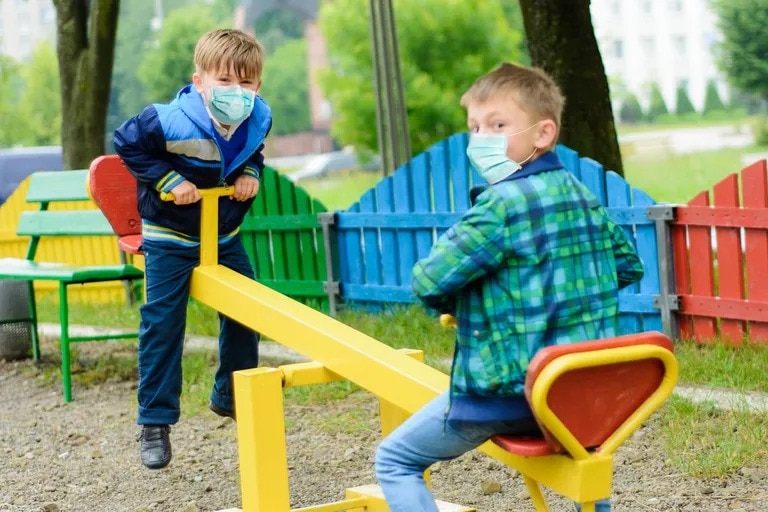Is It Safe for Children to Play Outside During COVID-19?

The COVID-19 pandemic has been difficult for everyone and children are no exception, suddenly and without warning, their lives were turned upside down in March 2020, day care centers and schools closed their doors, their daily routines were capsized. And their connection to the outside world was cut off.
Even though some schools and daycare centers have reopened and many of our children have adjusted to the “new normal”, things are still not the same. There are still many restrictions and masks, distancing and hand sanitizer have become routine.
As parents, we are doing everything we can to make their lives as comfortable and full as we can as the pandemic continues. Doing so means weighing the risks of every activity we allow them to participate in. And the truth is, having a grasp on what is safe and what isn’t can get very confusing!
One area that has many parents confused is whether or not it’s safe for their kids to enjoy the great outdoors and participate in outside activities.
In terms of COVID-19 transmission, we’ve been told that outside spaces are generally safer than inside spaces. Still, exactly how to navigate these outside activities—and how to make them as safe as possible—can be difficult to understand.
It’s always best to turn to the experts. So, let’s look at what guidance from the Centers for Disease Control and Prevention (CDC) and American Academy of Pediatrics (AAP) tells us about outside activities for our children.
What to Know About Outside Activities and COVID-19
The general consensus is that when it comes to COVID-19 transmission, outside activities are generally safer than inside activities. There are a few basic reasons for this: outside spaces usually allow more room for social distancing and outside spaces allow for optimal ventilation.
You are most likely to catch COVID-19 from what you breathe, rather than what you touch or eat. Therefore, ventilation is really important as the more the air circulates, the less likely the virus particles that one person sneezed, coughed, or breathed out will end up in the air that you breathe in.
As the CDC explains, “Indoor spaces are more risky than outdoor spaces where it might be harder to keep people apart and there’s less ventilation.”1 However, as the CDC points out, all activities pose some risk, so just holding an activity outside does not mean there is no risk for transmission of the virus.
Minimizing your risk in outside spaces should also include making sure to practice social distancing, limiting the number of people you engage with, and wearing masks.
Masks For Children Older Than Two
Masks can be worn by kids over the age of two, unless they have medical issues that prevent this. It’s rare that a child has a condition that prevents them from wearing a mask; any concerns about this should be discussed with your pediatrician.
How to Make Masks for Kids They Will Actually Wear
What to Know About Kids and COVID-19 Transmission
In addition to understanding the best ways to engage in outside play during COVID-19, it’s important to understand the risk your child faces.
Although children—even the youngest ones—can become infected with COVID-19, their symptoms are generally milder than adults. Some children have no symptoms at all—though they still can be contagious if they are infected—and others have symptoms such as fever, cough, and fatigue.
This fact is the hallmark of COVID-19—where there are so many adults AND kid who are infected AND contagious—yet asymptomatic. With most other viruses, you are contagious shortly before showing symptoms, which is true with COVID-19, but with other viruses you almost always develop some symptoms.
Although less common, some children do develop severe complications which require hospitalization and some children have tragically passed away from COVID-19. Though rare, children sometimes experience a syndrome several weeks after a COVID-19 infection called multisystem inflammatory syndrome in children (MIS-C). MIS-C causes rash, inflammation, and organ failure. MIS-C can be treated, but if it’s not treated promptly, it can be life threatening.
But besides the risks that COVID-19 can have on your child, if your child becomes infected with COVID-19, they can pass it to your family members, your extended family, and to others in their community.
This is part of why it’s so important for you and your family to take COVID-19 precautions seriously, including during outside play—because even if contracting the virus doesn’t feel like that big of a deal to your child or even to you, you could spread it to more vulnerable people.
Keeping Your Kids Safe From COVID-19
Factors That Make Outside Play Safer
In and of itself, just deciding to conduct an activity outside doesn’t necessarily make it risk-free. Outside spaces help immensely with the ventilation factor, but if other precautions aren’t also taken, outside activities can be risky.
Therefore, it’s important to understand what other factors should be in place in order to make outdoor activities less risky and as safe as possible.
Decreasing the risk of COVID-19 transmission depends on several factors, according to the CDC, including:1
- How many people you are interacting with (the fewer people you interact with, the less of a chance you have of getting infected)
- Whether the people you are interacting with are social distancing (standing at least 6 feet from one another)
- Whether the people you are interacting with are wearing masks
- How long you are interacting (the longer you interact with others, the higher likelihood of infection)
- What the community transmission rate in in your particular area (the higher the transmission rate, the higher the likelihood that someone you are with is infected)
So, in a nutshell, being outside with just your immediate family would be the safest scenario. But meeting up with others in outside environments can be made safer by limiting the number of people, practicing social distancing, wearing masks, and checking the community transmissions rates in your area before gathering.
Will COVID-19 Social Pods Be Safe This Winter?
Safe Outdoor Activities
The pandemic has taken so much from our children, which is why we should make the most of what we have and let our children participate in as many safe activities as possible. The good news is that most outside activities can be made safe for our children.
As the AAP points out, besides the need for our children to have a little fun, being outside is healthy for our children.2 It gets them moving, it connects them to nature, it promotes positive behavior, and it enhances learning.
Outside activities are a safer “outside the house” activity and can even be a safer way for them to gather with others. Still, certain outside activities may be safer than others, and implementing some simple precautions can go a long way in making different activities as safe as possible.
Are Parks and Recreation Areas Safe During COVID-19?
Visiting parks, nature preserves, and other outside recreation areas is a wonderful way for your child to get out of the house, exercise, and connect with nature. Hiking is a great family activity, as is picnicking, taking a nature stroll, collecting rock and flowers, and enjoying imaginative play.
Making a day at the park or recreation area safer means keeping a few basic things in mind, as described by the CDC:3
- Activities that involve your immediate family are safest, and may be the wisest choice if you live somewhere experiencing a widespread outbreak of COVID-19
- Choosing locations with the fewest people possible is also smart
- If you are going to interact with others, make sure you maintain social distance and wear a mask
- Wash your hands often with soap and water or use hand sanitizer
- Visit parks and recreation areas close to home to minimize travel, which can expose you to the virus
You should also contact the park, beach, or recreation area you would like to visit beforehand; some are closed because of the pandemic.
Playgrounds
At different phases of the pandemic, playgrounds have been closed. You might be unsure if the playground is a safe place for your child to play, even when it’s opened. Yet most of us really want to take our kids to the playground—it’s a great way for our kids to play, get exercise, and blow off steam.
So what’s the deal with playgrounds? Are they safe for kids? According to the CDC, it depends on a few different factors:3
- Look at how crowded a playground is. The more densely packed a group of children is, the harder social distancing can be.
- Determine if people are wearing masks. If people are wearing masks, the risk of transmission is much lower.
- Encourage kids not to touch their faces while playing and to wear a mask.
- Sanitize your child\\’s hands before and after playing either with soap and water or a hand sanitizer.
If you do choose to take your child to the playground, you might consider doing so when fewer kids are there (early or later in the day), and make sure to take hand sanitizer with you so that you can keep your child’s hands clean.
Another factor is the age and maturity of your child. For instance, maintaining distance can be really hard to do at a playground. Ask yourself if your child has the maturity to avoid playing with kids who are not wearing masks. Also, work with your kids on not touching their face or putting their hands in their mouth or eyes.
Recreational Sports
Youth sports are a fantastic way for your child to get exercise, bond with other kids, and mature and grow. Many sports leagues have started up again since the pandemic began and some reopened schools have resumed extracurricular sports. The additional plus about sports is that most of them can be done outdoors which can make them safer.
However, there are some factors that should be taken into consideration when it comes to recreational sports for kids. As the AAP points out, there are some factors that increase your risk while playing recreational sports:4
- Whether or not players and coaches are wearing masks
- How many children are participating—the fewer, the better
- How densely packed the children are and how able they are to socially distance while playing
- How much direct contact is required for play (running/track is safer than contact sports like football or basketball)
- The equipment used and whether players are sharing the equipment
- How long any direct interaction takes place
- Whether or not the team travels (traveling increases risk)
Outside Playdates
Allowing kids to play with their friends is important—social distancing and isolation can be very tough for children of all ages. Many parents wonder if allowing their kids to have play dates with their peers is safe. Unfortunately, most experts, including the AAP5 and Harvard Health,6 say that getting together with others in the form of playdates and sleepovers is not the best idea during the pandemic.
However, playing with another child outdoors may be a viable option, according to Harvard Health. In those circumstances, you will want to make sure that children can maintain social distancing and wear masks where appropriate.
It can be helpful to schedule outside activities that lend themselves to social distancing, such as hiking or bike riding. Organized activities like golfing or fitness classes can also allow your child to be close to their friends but maintain distance.
If your child doesn’t seem mature enough to have a safe outside playdate, you might want to consider a virtual play date. It can take some getting used to but even the youngest kids can get something out of a saying hello to their friends on FaceTime or Zoom.
A Word from Verywell
Trying to keep our kids happy and also safe during the COVID-19 pandemic has not been without stress. As parents, it can be so upsetting to see our children suffer from loneliness and isolation. Thankfully, allowing our kids to play outside is one of the safest activities for them during the pandemic. That’s a good thing, because most children thrive in outdoor spaces.
Still, it can be very difficult to balance our children feeling free as they play outside and making sure that proper COVID-19 precautions are followed.
A positive attitude can go a long way: if parents normalize social distancing and mask wearing, it’s more likely that our kids will accept it too. And all of these experiences are good ways to build up your child’s resilience as well as their empathy for others.
As hard as this all is, it won’t be forever. Like everything about this pandemic (and about parenting in general), it’s only for now. With love and support, our kids will be okay in the end.

